考研作文 传统文化
- 格式:doc
- 大小:12.50 KB
- 文档页数:2

申论作文万能模板传统文化传统文化是一个国家的灵魂和根基,它承载着民族的智慧和精神,是国家和民族的宝贵财富。
然而,在当今社会,随着现代化的发展和全球化的影响,传统文化正在逐渐淡化和消失。
因此,我们应该重视传统文化的传承和发展,让传统文化在当代社会中焕发新的生机和活力。
首先,传统文化是一个国家的瑰宝,它包含了丰富的历史、传统、习俗、价值观念等,是国家和民族的精神支柱。
传统文化不仅是国家的文化底蕴,更是国家形象和软实力的重要组成部分。
在当今世界,各国之间的竞争不仅仅是经济和科技的竞争,更是文化的竞争。
因此,传统文化的传承和发展对一个国家的发展至关重要。
其次,传统文化是人类智慧的结晶,它蕴含着丰富的哲学、艺术、科学和技术。
传统文化中的许多价值观念和智慧成果,对当今社会依然具有重要的启示和指导意义。
比如,儒家思想中的仁、义、礼、智、信等价值观念,对于当今社会的道德建设和社会治理具有重要的指导作用。
又如,中国的传统医学、书法、绘画、音乐等艺术形式,对当代艺术和文化的发展也有着深远的影响。
因此,传统文化的传承和发展对于人类的文明进步具有重要的意义。
然而,传统文化在当今社会面临着许多挑战和困境。
随着现代化的发展和全球化的影响,传统文化正在逐渐淡化和消失。
许多传统文化的传承人正在减少,传统文化的传承和发展面临着严峻的挑战。
同时,一些新兴的文化形式和价值观念也在冲击着传统文化,使传统文化的地位和影响力受到了一定的冲击。
因此,我们应该重视传统文化的传承和发展,让传统文化在当代社会中焕发新的生机和活力。
为了传承和发展传统文化,我们应该采取一系列的措施。
首先,政府应该加大对传统文化的扶持和保护力度,出台相关的政策和法规,加强对传统文化的保护和传承。
同时,学校和社会应该加强对传统文化的教育和宣传,让更多的人了解和热爱传统文化。
另外,传统文化的传承人应该加强自身的修养和学习,不断提高自己的传统文化传承能力。
同时,社会应该加强对传统文化的研究和挖掘,让传统文化在当代社会中焕发新的生机和活力。

2011年作文考研英语二2011年考研英语二作文题目,人们对于传统文化的态度。
参考范文:In recent years, traditional culture has been receiving increasing attention and recognition in China. People have been showing great interest in traditional customs, festivals, and arts. This phenomenon is mainly due to the following reasons.First and foremost, the rapid development of modern society has made people feel a sense of loss and emptiness. In the process of pursuing material wealth and modernization, people have gradually realized that they have lost something valuable and meaningful. Traditional culture, as the root of a nation, carries the wisdom and experience of our ancestors, which can provide us with guidance and inspiration in our lives. Therefore, people begin to turn their attention back to traditional culturein order to seek spiritual comfort and find a sense of belonging.Secondly, with the improvement of people's living standards, they have more leisure time and disposable income to explore traditional culture. In the past, people were too busy making a living and had little time and energy to appreciate traditional culture. However, as the society becomes more affluent and people's lives become more comfortable, they have more opportunities to engage in cultural activities and explore the richness of traditional culture. For example, many people now choose to travel to historical and cultural sites during holidays, visit museums and exhibitions, or participate in traditional festivals and ceremonies. These activities not only enrich people's lives but also help them to better understand and appreciate their own cultural heritage.Furthermore, the government's efforts to promote traditional culture have also played a significant role in arousing people's interest. In recent years, the government has launched various campaigns and initiatives to protectand promote traditional culture. For example, traditional festivals and cultural events are often organized in cities and towns, attracting a large number of participants. In addition, traditional arts and crafts are being revived and promoted, such as traditional Chinese painting, calligraphy, and embroidery. These efforts have not only preserved the traditional culture but also made it more accessible and appealing to the general public.However, it is worth noting that while the revival of traditional culture is a positive trend, it also faces challenges and criticisms. Some people argue thattraditional culture is outdated and irrelevant in today's fast-changing world. They believe that the emphasis on tradition may hinder the progress and development of society. Moreover, the commercialization of traditional culture has also raised concerns. Some cultural relics and traditions are being exploited for profit, which may leadto their distortion and loss of authenticity.In conclusion, the increasing attention and recognition of traditional culture in China can be attributed tovarious factors, including the sense of loss in modern society, the improvement of people's living standards, and the government's efforts to promote traditional culture. While there are challenges and criticisms, the revival of traditional culture has brought spiritual comfort and a sense of belonging to people's lives. It is important to strike a balance between preserving tradition and embracing modernity, in order to fully appreciate the richness and diversity of our cultural heritage.。

传统文化申论范文传统文化在当今社会中的重要性。
传统文化是一个国家、一个民族的根基和灵魂,它蕴含着丰富的历史、文化和精神内涵,是民族的宝贵财富。
在当今社会,传统文化依然具有重要的意义和价值,它不仅是我们民族的瑰宝,更是我们民族的精神支柱。
因此,我们应该珍惜和传承传统文化,让它在当今社会中绽放出更加绚丽的光芒。
首先,传统文化是我们民族的瑰宝,它承载着我们民族的悠久历史和丰富文化。
在传统文化中,包括了我们民族的语言、文字、文学、艺术、宗教、哲学、道德、礼仪等方方面面,这些都是我们民族的宝贵财富。
例如,中国的传统文化中包括了汉字、诗词、书法、绘画、戏曲、舞蹈等,这些都是我们民族的独特文化符号,是我们民族的骄傲和自豪。
因此,传统文化是我们民族的瑰宝,我们应该珍惜和传承它。
其次,传统文化是我们民族的精神支柱,它蕴含着丰富的精神内涵和价值观念。
在传统文化中,包括了我们民族的传统美德、家国情怀、孝道忠诚、仁义礼智信等传统价值观念,这些都是我们民族的精神支柱。
例如,中国的传统文化中强调了孝道、忠诚、仁爱、礼仪等传统美德,这些都是我们民族的传统价值观念,是我们民族的精神支柱。
因此,传统文化是我们民族的精神支柱,我们应该传承和弘扬它。
再次,传统文化是我们民族的文化自信和民族自豪的重要源泉。
在当今世界,文化交流和文化冲突日益频繁,各种文化价值观念相互碰撞和交锋。
而我们的传统文化正是我们民族的文化自信和民族自豪的重要源泉。
只有坚定文化自信,才能在文化交流中保持自己的独特性和魅力,才能在文化冲突中保持自己的立场和底气。
因此,传统文化是我们民族的文化自信和民族自豪的重要源泉,我们应该坚定文化自信,传承和发扬我们的传统文化。
总之,传统文化在当今社会中依然具有重要的意义和价值,它是我们民族的瑰宝、精神支柱和文化自信的重要源泉。
因此,我们应该珍惜和传承传统文化,让它在当今社会中绽放出更加绚丽的光芒。
只有如此,我们才能在文化交流中保持自己的独特性和魅力,才能在文化冲突中保持自己的立场和底气。
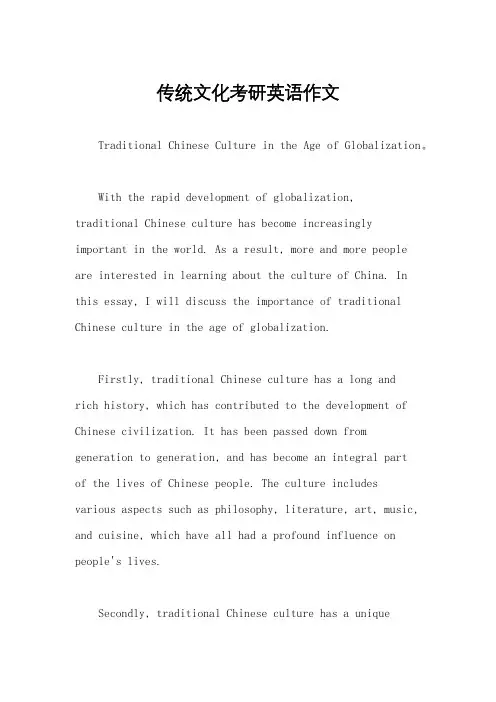
传统文化考研英语作文Traditional Chinese Culture in the Age of Globalization。
With the rapid development of globalization,traditional Chinese culture has become increasingly important in the world. As a result, more and more people are interested in learning about the culture of China. In this essay, I will discuss the importance of traditional Chinese culture in the age of globalization.Firstly, traditional Chinese culture has a long andrich history, which has contributed to the development of Chinese civilization. It has been passed down from generation to generation, and has become an integral partof the lives of Chinese people. The culture includesvarious aspects such as philosophy, literature, art, music, and cuisine, which have all had a profound influence on people's lives.Secondly, traditional Chinese culture has a uniquecharm that attracts people from all over the world. For example, Chinese calligraphy is known for its beauty and elegance, while Chinese painting is famous for its unique style and techniques. Chinese cuisine is also loved by people all over the world for its rich flavors and unique cooking methods.Thirdly, traditional Chinese culture has played an important role in promoting cultural exchange and communication between China and other countries. As moreand more people are interested in learning about Chinese culture, there are more opportunities for cultural exchange and cooperation. This has led to a better understanding of Chinese culture and has helped to promote culturaldiversity and mutual respect.However, in the age of globalization, traditional Chinese culture is facing many challenges. With the rapid development of modern technology, people are becoming more and more inclined towards Western culture, and traditional Chinese culture is gradually losing its appeal. In addition, the lack of cultural preservation and protection has alsoled to the loss of many valuable cultural relics and traditions.To preserve and promote traditional Chinese culture, we need to take action. Firstly, we need to strengthencultural education and encourage more people to learn about traditional Chinese culture. Secondly, we need to protect and preserve cultural relics and traditions, and promote cultural exchange and cooperation between China and other countries. Thirdly, we need to make use of modern technology to promote traditional Chinese culture, such as through the development of cultural tourism and the use of social media.In conclusion, traditional Chinese culture is an important part of Chinese civilization and has a unique charm that attracts people from all over the world. With the development of globalization, we need to take action to preserve and promote traditional Chinese culture, and to promote cultural exchange and cooperation between China and other countries. Only by doing so can we ensure thattraditional Chinese culture will continue to thrive and contribute to the world.。
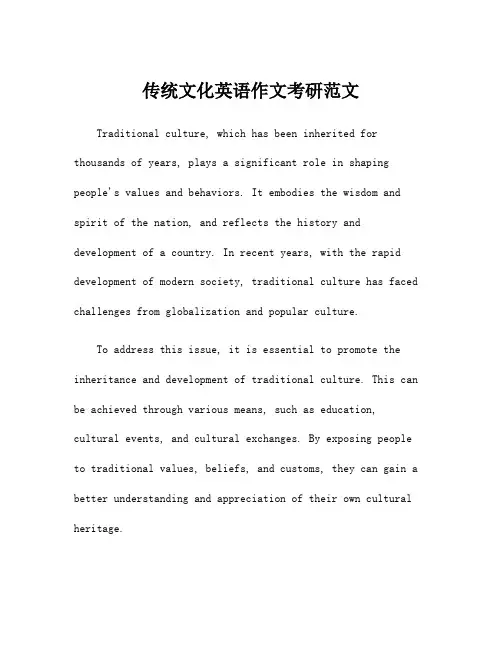
传统文化英语作文考研范文Traditional culture, which has been inherited for thousands of years, plays a significant role in shaping people's values and behaviors. It embodies the wisdom and spirit of the nation, and reflects the history and development of a country. In recent years, with the rapid development of modern society, traditional culture has faced challenges from globalization and popular culture.To address this issue, it is essential to promote the inheritance and development of traditional culture. This can be achieved through various means, such as education, cultural events, and cultural exchanges. By exposing people to traditional values, beliefs, and customs, they can gain a better understanding and appreciation of their own cultural heritage.Additionally, efforts should be made to integrate traditional culture into modern life. This can be done through the revitalization of traditional art forms, the preservation of historical sites, and the promotion of traditional practices. By incorporating traditional culture into everyday life, people can maintain a strong connection to their cultural roots.Furthermore, traditional culture can serve as a bridgefor cultural exchanges and mutual understanding among countries. Through the promotion of traditional art, music, dance, and literature, countries can enhance their cultural diplomacy and foster global harmony and cooperation.In conclusion, traditional culture is an invaluable asset that should be cherished and preserved. By promoting its inheritance and development, integrating it into modern life, and utilizing it as a tool for cultural exchange, traditionalculture can continue to enrich the lives of people and contribute to the diversity and harmony of the world.。
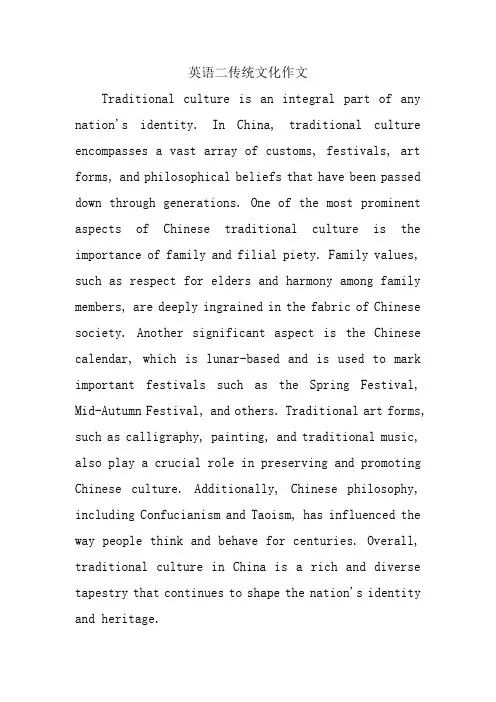
英语二传统文化作文Traditional culture is an integral part of any nation's identity. In China, traditional culture encompasses a vast array of customs, festivals, art forms, and philosophical beliefs that have been passed down through generations. One of the most prominent aspects of Chinese traditional culture is the importance of family and filial piety. Family values, such as respect for elders and harmony among family members, are deeply ingrained in the fabric of Chinese society. Another significant aspect is the Chinese calendar, which is lunar-based and is used to mark important festivals such as the Spring Festival, Mid-Autumn Festival, and others. Traditional art forms, such as calligraphy, painting, and traditional music, also play a crucial role in preserving and promoting Chinese culture. Additionally, Chinese philosophy, including Confucianism and Taoism, has influenced the way people think and behave for centuries. Overall, traditional culture in China is a rich and diverse tapestry that continues to shape the nation's identity and heritage.中文翻译:传统文化是一个国家身份的重要组成部分。

传统文化考试论文五篇第一篇:传统文化考试论文浅谈中国传统文化在现代化中的危机XXX老师讲过,“传”和“统”在古籍中是分开用的,都表示世代相继的意思。
刘熙的《释名》说:“传,传也,以传示后人也。
”颜师古注《汉书》时引他人语说:“统,继也。
”如儒家圣贤相传的“道统”、佛教表钵相传的“法统”。
都是指前后继承的意思。
传统可以意味着许多的事物,许多代代相传的事物。
这些事物包括物质实体也包括人们对各种事物的信仰,还包括延续已久的惯例和制度。
它可以是建筑物、纪念碑、景物、雕塑、绘画、书籍、工具和机器、节日,语言等等。
由此,我们可以看到,所谓传统不是静止的事物,它是一个开放的动态系统,它是将以上代代相传的事物在时间、空间中延续和发展,是一种意识之流或趋势。
它从过去到现在,同时在不断发展、丰富,交流、传递中开拓和影响着未来。
传统文化不意味着是过去的文化,它是历史的,又是现实的,它存在于我们的血液里.我们的言谈举止中.我们的衣食住行。
有了人类,就有了人类活动,有了人类历史,就有了人类所创造的文化。
正是这种继承,传承和延续才使中华民族绵延5000年,而经久不衰。
我们也承认这个现实,毕竟古代四大文明,唯中华民族还屹立于地球之上。
但我们又不得不面对现实,中国传统文化绵延到21世纪正面临断子绝孙、无以为继的重大危机。
记得是2010年6月英语四级的作文题目:如何看待近年来,在不少中国人中出现了忽视中文的现象。
英语考试中出现这样的题目,很特别,感觉是对中国文化没落的无声讽刺。
讽刺我们这些对英语过级盲目痴迷的人,同时也让我意识到,我们的母语正面临着严重的危机,将来无以为继。
如果你每天清晨,在大学校园里走走,你会发现,整个校园弥漫着琅琅上口的英语,而不见我们的语言,我们的传统文化。
我们平时过多注重学习英语,而中国字写不好,母语不爱学,对中国历史文化知之甚少。
也许这不是我们的错。
因为我们这样做的目的是就毕业,学生毕业后的就业往往“因需施教”,公司,企业只注重专业课程的拓展和加深以及外语的能力,忽视了对学生综合能力的开发,更忽视了对中国传统文化知识的继承与发扬,致使一些大学生在与外国人谈及中国历史时哑口无言的情况屡见不鲜。
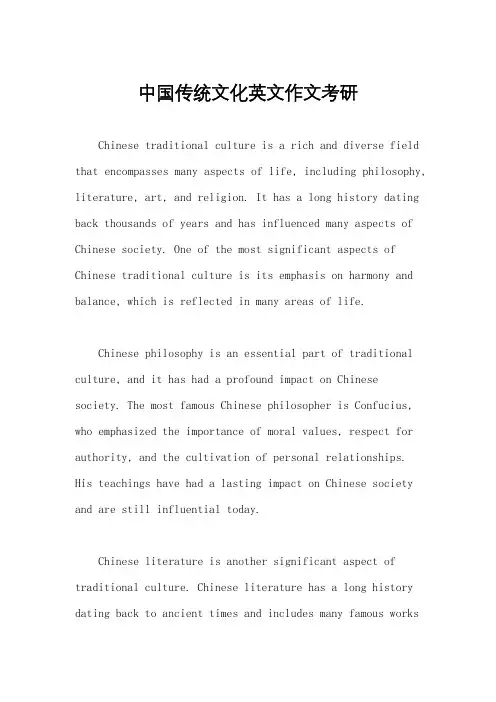
中国传统文化英文作文考研Chinese traditional culture is a rich and diverse field that encompasses many aspects of life, including philosophy, literature, art, and religion. It has a long history dating back thousands of years and has influenced many aspects of Chinese society. One of the most significant aspects of Chinese traditional culture is its emphasis on harmony and balance, which is reflected in many areas of life.Chinese philosophy is an essential part of traditional culture, and it has had a profound impact on Chinese society. The most famous Chinese philosopher is Confucius, who emphasized the importance of moral values, respect for authority, and the cultivation of personal relationships. His teachings have had a lasting impact on Chinese society and are still influential today.Chinese literature is another significant aspect of traditional culture. Chinese literature has a long history dating back to ancient times and includes many famous workssuch as "The Dream of the Red Chamber," "Journey to the West," and "Romance of the Three Kingdoms." These works are not only entertaining but also provide insight into Chinese society and culture.Chinese art is also an essential part of traditional culture. Chinese art includes many forms such as calligraphy, painting, and sculpture. Chinese calligraphy is a highly respected art form, and it is often used to express personal feelings and emotions. Chinese painting is also highly valued, and it often depicts natural scenes such as landscapes, flowers, and birds.Religion is also an essential aspect of Chinese traditional culture. The most significant religions in China are Buddhism, Taoism, and Confucianism. Buddhism emphasizes the importance of personal enlightenment, while Taoism focuses on living in harmony with nature. Confucianism emphasizes the importance of moral values and respect for authority.In conclusion, Chinese traditional culture is a richand diverse field that encompasses many aspects of life. It has a long history and has had a profound impact on Chinese society. Its emphasis on harmony and balance is reflectedin many areas of life, including philosophy, literature, art, and religion.。
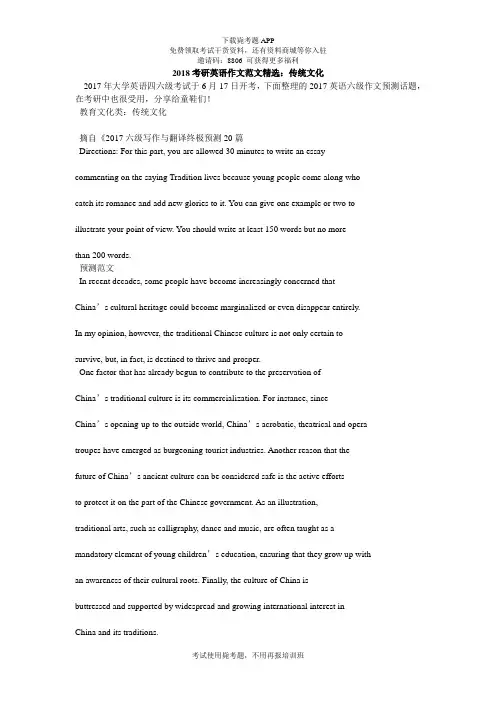
2018考研英语作文范文精选:传统文化2017年大学英语四六级考试于6月17日开考,下面整理的2017英语六级作文预测话题,在考研中也很受用,分享给童鞋们!教育文化类:传统文化摘自《2017六级写作与翻译终极预测20篇Directions: For this part, you are allowed 30 minutes to write an essaycommenting on the saying Tradition lives because young people come along whocatch its romance and add new glories to it. You can give one example or two toillustrate your point of view. You should write at least 150 words but no morethan 200 words.预测范文In recent decades, some people have become increasingly concerned thatChina’s cultural heritage could become marginalized or even disappear entirely.In my opinion, however, the traditional Chinese culture is not only certain tosurvive, but, in fact, is destined to thrive and prosper.One factor that has already begun to contribute to the preservation ofChina’s traditional culture is its commercialization. For instance, sinceChina’s opening-up to the outside world, China’s acrobatic, theatrical and operatroupes have emerged as burgeoning tourist industries. Another reason that thefuture of China’s ancient culture can be considered safe is the active effortsto protect it on the part of the Chinese government. As an illustration,traditional arts, such as calligraphy, dance and music, are often taught as amandatory element of young children’s education, ensuring that they grow up withan awareness of their cultural roots. Finally, the culture of China isbuttressed and supported by widespread and growing international interest inChina and its traditions.As a result of successful commercialization efforts, unwavering governmentsupport and growing interest overseas, the future of China’traditional culturelooks brighter and more secure than ever before. (191 words)参考译文最近几十年来,一些人已越来越担心中国的文化遗产可能会边缘化或者完全消失。
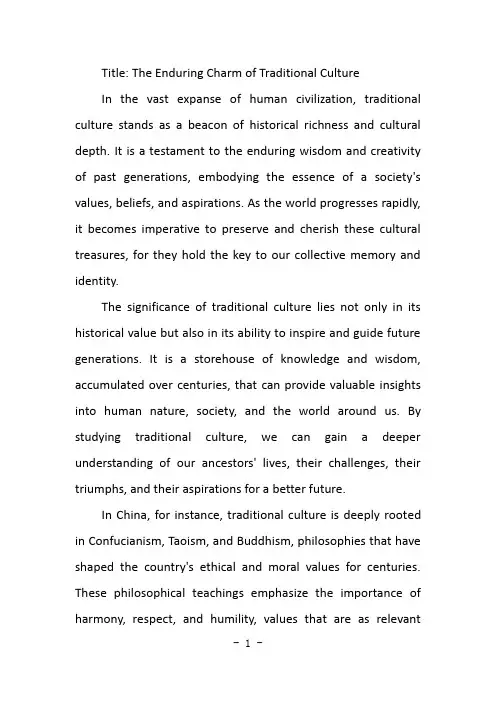
Title: The Enduring Charm of Traditional CultureIn the vast expanse of human civilization, traditional culture stands as a beacon of historical richness and cultural depth. It is a testament to the enduring wisdom and creativity of past generations, embodying the essence of a society's values, beliefs, and aspirations. As the world progresses rapidly, it becomes imperative to preserve and cherish these cultural treasures, for they hold the key to our collective memory and identity.The significance of traditional culture lies not only in its historical value but also in its ability to inspire and guide future generations. It is a storehouse of knowledge and wisdom, accumulated over centuries, that can provide valuable insights into human nature, society, and the world around us. By studying traditional culture, we can gain a deeper understanding of our ancestors' lives, their challenges, their triumphs, and their aspirations for a better future.In China, for instance, traditional culture is deeply rooted in Confucianism, Taoism, and Buddhism, philosophies that have shaped the country's ethical and moral values for centuries. These philosophical teachings emphasize the importance of harmony, respect, and humility, values that are as relevanttoday as they were in ancient times. The study of classical literature, such as the works of Confucius, Lao Tzu, and other ancient scholars, reveals profound truths about humanity and our place in the universe.Moreover, traditional culture encompasses a wide range of artistic expressions, including music, dance, theater, and visual arts. These forms of art not only entertain but also educate, transmitting important social and cultural values from one generation to the next. For example, Chinese opera, with its extravagant costumes, melodious singing, and graceful movements, is a powerful medium for storytelling and conveying moral and ethical messages.However, the preservation of traditional culture is not without its challenges. Globalization and modernization have brought about significant changes in societal values and lifestyles, often leading to the neglect or even abandonment of traditional practices and beliefs. To counteract this trend, it is crucial that we recognize the importance of traditional culture and take active measures to preserve it.One way to do this is through education. By incorporating traditional culture into the curriculum at all levels of education, we can ensure that future generations understand andappreciate their cultural heritage. Schools and universities should offer courses on traditional culture, including history, art, music, and literature, to foster a deeper understanding and respect for these values among students.Another effective way to preserve traditional culture is through community events and celebrations. Festivals, for instance, often involve traditional customs, foods, and performances that are passed down through generations. By actively participating in these events, community members can keep these traditions alive and pass them on to younger generations.In conclusion, traditional culture is a precious inheritance that must be preserved and cherished. It represents the historical and cultural richness of a society, embodying the wisdom and creativity of past generations. By studying and celebrating our traditional culture, we can gain valuable insights into our ancestors' lives, understand our own identity and values, and transmit these to future generations. Let us strive to protect and nurture this cultural heritage, for it holds the key to our past, present, and future.。
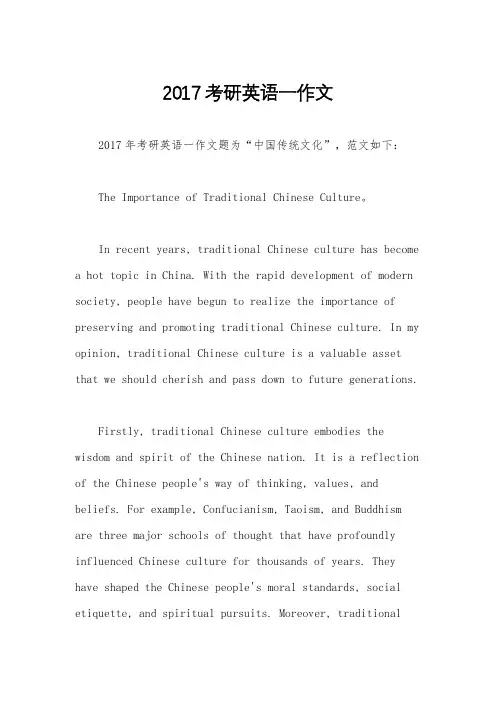
2017考研英语一作文2017年考研英语一作文题为“中国传统文化”,范文如下:The Importance of Traditional Chinese Culture。
In recent years, traditional Chinese culture has become a hot topic in China. With the rapid development of modern society, people have begun to realize the importance of preserving and promoting traditional Chinese culture. In my opinion, traditional Chinese culture is a valuable asset that we should cherish and pass down to future generations.Firstly, traditional Chinese culture embodies the wisdom and spirit of the Chinese nation. It is a reflection of the Chinese people's way of thinking, values, and beliefs. For example, Confucianism, Taoism, and Buddhism are three major schools of thought that have profoundly influenced Chinese culture for thousands of years. They have shaped the Chinese people's moral standards, social etiquette, and spiritual pursuits. Moreover, traditionalChinese culture is rich in art, literature, music, and architecture, which are all expressions of the Chinese people's creativity and aesthetic sense.Secondly, traditional Chinese culture is a source of national pride and identity. It is a symbol of China's long and glorious history and civilization. By learning about traditional Chinese culture, we can gain a deeper understanding of our roots and heritage. We can also appreciate the diversity and richness of Chinese culture, as well as its contributions to world civilization. For example, Chinese calligraphy, painting, and porcelain are highly acclaimed around the world for their beauty and cultural significance.Thirdly, traditional Chinese culture has practical value in today's world. As China becomes more integrated into the global community, traditional Chinese culture can serve as a bridge between China and other countries. It can help to promote mutual understanding, respect, and cooperation. For example, Chinese cuisine, martial arts, and traditional medicine are all popular abroad and havecontributed to cultural exchange and economic development.In conclusion, traditional Chinese culture is an invaluable treasure that we should cherish and promote. It reflects the wisdom and spirit of the Chinese nation, instills a sense of national pride and identity, and has practical value in today's world. As Chinese people, we should take pride in our cultural heritage and strive to pass it down to future generations. Only by doing so can we preserve our unique identity and contribute to thediversity and richness of world civilization.。
考研英语作文传统文化Traditional culture is an essential part of ouridentity and heritage. It reflects the values, beliefs, and customs passed down through generations.One of the most fascinating aspects of traditional culture is its diversity. Different regions and ethnic groups have their unique traditions and practices, adding richness and depth to our cultural tapestry.Traditional culture also serves as a bridge between the past and the present, connecting us to our roots and providing a sense of continuity in an ever-changing world.In today's fast-paced society, traditional culture can offer a sense of grounding and stability. It reminds us of the importance of slowing down, appreciating the simple things in life, and staying connected to our community.Preserving traditional culture is crucial for futuregenerations. It allows them to learn about their heritage, develop a sense of pride in their roots, and carry on the traditions that have been passed down to them.In conclusion, traditional culture is a precious treasure that should be cherished and preserved. It not only enriches our lives but also provides a sense of belonging and identity in an increasingly globalized world.。
中文考研写作试题及答案试题:根据题目所给材料,写一篇不少于800字的议论文。
请在文章中引用材料内容,并结合自己的理解和观点,阐述对于“传统文化在现代社会中的重要性”的看法。
材料:随着全球化的不断深入,各种文化交汇融合,形成了多元文化的大熔炉。
然而,传统文化在这一过程中似乎逐渐被边缘化。
有人认为,传统文化是民族的根和魂,是不可替代的;也有人认为,传统文化应该与时俱进,与现代生活相适应。
请以“传统文化在现代社会中的重要性”为题,写一篇文章。
答案:传统文化在现代社会中的重要性在全球化的大背景下,世界各民族文化的交流与融合日益频繁,形成了一个多元文化的大熔炉。
然而,这一过程中,传统文化的保护与发展却面临着前所未有的挑战。
传统文化不仅是一个民族的历史记忆,更是其精神象征,对于现代社会而言,其重要性不言而喻。
首先,传统文化是一个民族的根和魂,它承载着民族的历史、哲学、道德观念和审美情趣。
这种文化传统是民族身份的重要标志,是民族精神的重要组成部分。
在现代社会中,传统文化的传承与发展,有助于增强民族自信心和凝聚力,促进社会和谐稳定。
例如,中国的春节、端午节等传统节日,不仅是家人团聚的时刻,也是传承民族文化、弘扬民族精神的重要途径。
其次,传统文化是现代社会创新的源泉。
许多现代科技和艺术形式的发展,都离不开对传统文化的深入挖掘和创新性转化。
传统文化中的哲学思想、道德观念和审美价值,可以为现代社会提供丰富的思考角度和创新灵感。
例如,中国传统的“天人合一”思想,对于当今环保和可持续发展的理念有着重要的启示作用。
然而,传统文化并非一成不变,它需要与时俱进,与现代生活相适应。
传统文化的传承并不是简单的复制和模仿,而是要在继承的基础上进行创新和发展。
这要求我们既要保护和尊重传统文化,又要敢于对其进行现代化的改造和创新,使其更加符合现代社会的需求。
此外,传统文化在现代社会中的传播和教育也非常重要。
通过教育和传播,可以让更多人了解和认识传统文化,从而增强文化自觉和文化自信。
考研英语作文预测-中国传统文化【预测四】中国传统文化As is symbolically indicated in the eye-catching cartoon, in front of Confucius stands a modern young man with brown hair, drinking coke and eating hamburger, with a cap of foreign logos. Yet, the “Confucius” is writing calligraphy of Chinese character on his back. Not only informative is the implication, but instructive as well.What lies in this thought-provoking cartoon, or “buried” in the conflict of western and eastern culture, is clear: western culture mania will result in the loss of Chinese traditional customs.I can think of no better reasons other than the following ones. First and foremost, mass media might release 24/7 advertisements about the western cultures and attract a variety of people to buy western festival goods. Moreover, owing to the advancement of economy, people in mounting numbers are capable of purchasing foreign goods and celebrate western festivals, which will not cost too much. As a consequence, age-old customs and traditions may become lost in the shadows of modernization and commercialization.In conclusion, popularity of western culture might prove to be a double-edged sword. What we should do is to absorb the essence and neglect the drawbacks. Therefore, when appreciating the overseas cultures, we ourselves should also enhance the consciousness of the importance of our own culture such as Kung-fu and Peking opera. Only in this way never would our Chinese traditional culture perish in the future.。
传统文化作文带解析传统文化是一个民族的精神财富,也是一个国家的独特标志。
它是一个民族历史、价值观念、道德规范和艺术表达的综合体现。
传统文化的重要性不言而喻,它不仅可以让我们了解自己的根源,还可以提供给我们许多有益的启示和借鉴。
那么,传统文化对于一个国家的发展到底有多重要呢?英文回答:Traditional culture plays a vital role in the development of a country. Firstly, it helps to establish a sense of national identity and pride. By understanding and embracing our traditional culture, we can better understand our roots and heritage. This sense of identity can unite people and create a shared sense of belonging, which is essential for a country's unity and stability. For example, in China, the celebration of Chinese New Year and the practice of Confucianism are deeply rooted in traditional culture and are important symbols of Chinese identity.Secondly, traditional culture provides valuable lessons and wisdom that can guide us in our modern lives. Many traditional cultural practices and beliefs are based on centuries of accumulated knowledge and experience. For instance, the concept of filial piety in Confucianism emphasizes the importance of respecting and caring for our parents, which is still relevant and applicable today. By learning from our traditional culture, we can gain insights into the values and principles that have stood the test of time.Furthermore, traditional culture is a rich source of artistic expression and creativity. Traditional arts, such as calligraphy, painting, music, and dance, are not only aesthetically pleasing but also convey profound meanings and emotions. These art forms reflect the cultural and historical context of a society and can be a powerful medium for storytelling and communication. For example, Chinese ink painting often depicts natural landscapes and embodies the philosophy of harmony between man and nature.In addition, traditional culture can also contribute toeconomic development. Cultural tourism, for instance, has become a booming industry in many countries. Tourists are attracted to the unique cultural experiences and heritage sites that a country has to offer. This influx of tourists can stimulate local economies and create job opportunities for the local population. Moreover, traditional crafts and products, such as handmade textiles or pottery, can be marketed as high-quality and culturally authentic products, contributing to the growth of the creative industry.中文回答:传统文化在一个国家的发展中起着至关重要的作用。
英语二传统文化作文English:Chinese traditional culture is rich and diverse, encompassing various aspects such as philosophy, literature, music, art, and customs. It is deeply rooted in the long history of China, with Confucianism, Taoism, and Buddhism serving as the three main pillars influencing people's beliefs and way of life. Confucian values like filial piety, respect for elders, and the importance of education have been passed down through generations, shaping the moral compass of Chinese society. Traditional Chinese poetry, calligraphy, and painting reflect the beauty and elegance of the culture, while practices like the tea ceremony and traditional Chinese medicine highlight the holistic approach to health and well-being. These cultural traditions have been preserved and cherished by the Chinese people for thousands of years, serving as a source of national pride and identity.中文翻译:中国传统文化丰富多彩,包括哲学、文学、音乐、艺术和习俗等各个方面。
有关中国传统文化的考研英语作文全文共10篇示例,供读者参考篇1Title: Traditional Chinese CultureHey guys, have you ever heard about traditional Chinese culture? Well, let me tell you all about it! Traditional Chinese culture is super cool and has been around for thousands of years.One of the most famous things about Chinese culture is the Chinese New Year. It's a huge celebration with lots of delicious food, colorful decorations, and exciting performances like dragon dances and firecrackers. During the New Year, we also give each other red envelopes filled with money for good luck.Another important part of traditional Chinese culture is the philosophy of Confucianism. Confucius was a wise old dude who taught about respect, kindness, and living a good life. His teachings are still followed by many Chinese people today.We also have traditional Chinese festivals like theMid-Autumn Festival, where we eat yummy mooncakes and watch the full moon. And don't forget about the Dragon BoatFestival, where we race dragon boats and eat sticky rice dumplings.Traditional Chinese music and dance are also super cool. Have you ever heard the beautiful sound of a guzheng or seen the graceful movements of a Chinese dance? It's all part of our amazing culture.So, guys, traditional Chinese culture is really awesome and we should all be proud of it. Let's keep learning about our history and traditions so we can pass them on to future generations. Let's show the world how amazing Chinese culture is!篇2Hello everyone! Today, I'm going to talk about traditional Chinese culture. Traditional Chinese culture is super cool and interesting, just like a big adventure!First, let's talk about Chinese festivals. There are so many fun festivals in China, like the Spring Festival, Mid-Autumn Festival, and Dragon Boat Festival. During the Spring Festival, families get together to eat delicious food, give red envelopes, and watch dragon dances. It's like a big party! And during the Mid-Autumn Festival, we eat yummy mooncakes and look at the bright full moon. It's so magical!Next, let's talk about Chinese traditional clothes. Have you ever seen a beautiful cheongsam or a handsome changshan? These are traditional Chinese clothes that are so colorful and pretty. They look like they come from a fairy tale! And don't forget about the Chinese opera costumes. They are so elaborate and fancy, with bright colors and amazing patterns.Now, let's talk about Chinese calligraphy. Chinese calligraphy is like drawing with words. It's a form of art where people use brushes and ink to write beautiful characters. Each stroke is like a dance, flowing gracefully across the paper. It's so cool to watch and even cooler to try it yourself!Finally, let's talk about Chinese philosophy. Confucianism, Taoism, and Buddhism are three major philosophical beliefs in China. Confucianism teaches us about respect, loyalty, and kindness. Taoism teaches us about harmony with nature and finding inner peace. And Buddhism teaches us about compassion and letting go of desires. These teachings are like treasure chests of wisdom!In conclusion, traditional Chinese culture is like a colorful rainbow, shining with beauty and wisdom. It's so amazing to learn about and experience. I hope you can all take a journey intothe world of traditional Chinese culture and discover its wonders! Thank you for listening, and see you next time!篇3Title: Traditional Chinese CultureHi everyone, today I want to talk about traditional Chinese culture. Chinese culture is so cool and interesting, let's learn more about it together!First of all, let's talk about Chinese New Year. Have you ever celebrated Chinese New Year with your family? It's a super fun holiday where we eat lots of yummy food and watch colorful dragon dances. We also give red envelopes with money inside to bring good luck for the new year. It's a time to be with family and friends and celebrate all the good things that will come in the new year.Next, let's talk about the Great Wall of China. Have you heard of it before? It's one of the coolest things in China! The Great Wall is really long and was built to protect China from enemies long ago. It's so huge that you can even see it from space! It's a really important part of our history and culture.Another cool thing about Chinese culture is the traditional clothing. Have you seen people wearing beautiful silk dresses and suits with cool designs on them? That's traditional Chinese clothing! It's so colorful and pretty, and it's been a part of Chinese culture for a long time. People wear them for special occasions like weddings and festivals.Lastly, let's talk about Chinese calligraphy. Have you ever tried writing Chinese characters with a brush and ink? It's super fun! Chinese calligraphy is like an art form where you can express yourself with beautiful strokes and designs. It's a really cool way to learn more about Chinese culture and history.So that's a little bit about traditional Chinese culture. I hope you learned something new and interesting today. Chinese culture is so amazing and has so many cool things to explore. I hope you can learn more about it and maybe even try some of these things yourself. Thanks for listening!篇4Title: Let's Talk About Traditional Chinese CultureHey everyone! Today we are going to talk about traditional Chinese culture. Do you know that China has a really long historyand there are so many cool things about our culture that we can learn? Let's dive in and explore together!One super cool thing about Chinese culture is the Chinese zodiac. Have you heard of it before? It's like a special calendar that assigns an animal to each year in a cycle of 12 years. There are animals like the rat, ox, tiger, rabbit, dragon, snake, horse, goat, monkey, rooster, dog, and pig. Each animal has its own characteristics and people believe that the year you are born in can affect your personality and your future. How cool is that?Another awesome thing about Chinese culture is the traditional festivals. We have so many fun and interesting festivals like the Spring Festival, the Mid-Autumn Festival, and the Dragon Boat Festival. During these festivals, we get to eat yummy food, watch dragon dances, light lanterns, and spend time with our family and friends. It's a great way to celebrate and keep our traditions alive!Let's not forget about Chinese calligraphy and painting. Did you know that Chinese characters are like little pieces of art? They are so beautiful and each stroke has a special meaning. We can learn how to write Chinese characters and create our own paintings using ink and brushes. It's a great way to express ourselves and appreciate the beauty of our culture.In Chinese culture, respecting our elders is also very important. We learn to be polite, listen to our parents and teachers, and take care of our grandparents. It's all about showing gratitude and love to the people who have helped us grow and learn. This is what makes our culture so special and unique.So, there you have it! Traditional Chinese culture is full of amazing things that we can learn and appreciate. Let's continue to explore and pass down these traditions to the next generation. Let's be proud of our culture and embrace it with open arms. Thank you for listening and I hope you have a great day!篇5Title: Exploring China's Traditional CultureHey guys! Today I want to talk about China's traditional culture. It's super interesting and important, so keep reading to learn more!Firstly, let's talk about Chinese calligraphy. Have you guys ever seen those cool Chinese characters that people write with a brush? That's calligraphy! It's like an art form where you use special brushes and ink to create beautiful characters. It's beenaround for thousands of years and is a big part of Chinese culture.Next up, let's chat about Chinese festivals. There are so many fun festivals in China, like the Spring Festival (Chinese New Year), the Mid-Autumn Festival, and the Dragon Boat Festival. During these festivals, people eat delicious food, watch dragon boat races, and spend time with their families. It's a great way to celebrate and learn more about Chinese traditions.Now, let's talk about Chinese martial arts. You guys have probably seen movies with cool kung fu fighters, right? Well, that's Chinese martial arts! It's a traditional form of combat that focuses on strength, balance, and discipline. It's not just about fighting – it's also a way to stay healthy and build character.Finally, let's discuss the importance of respecting your elders in Chinese culture. In China, it's really important to show respect to your parents, grandparents, and other older family members. This includes listening to their advice, helping them out, and taking care of them when they need it. It's all about honoring your family and building strong relationships.So, that's a little peek into China's traditional culture. There's so much more to explore and learn about, so keep an open mind and dive into the rich history of China. It's an amazing journeythat will teach you a lot about the world around you. Thanks for reading, guys! See you next time!篇6Once upon a time, long long ago in China, there were lots of cool traditions and cultures. Let me tell you all about it!One of the most important parts of Chinese traditional culture is filial piety. That means kids like us need to respect and take care of our parents and grandparents. We should listen to them, help them out, and make them happy. It's super important to show love and gratitude to our family!Another awesome tradition is celebrating festivals. There are so many fun festivals in China, like the Spring Festival, Dragon Boat Festival, and Mid-Autumn Festival. During these festivals, we get to eat yummy food, play games, and watch traditional performances. It's a great time to spend with family and friends.Oh, and don't forget about Chinese calligraphy and painting! These are arts that have been around for thousands of years. Calligraphy is writing beautiful Chinese characters with a brush, and painting is creating amazing artworks with ink and colors. It's so cool to learn and practice these traditional arts.Chinese traditional culture also includes things like traditional medicine, tea ceremonies, and martial arts. These are all important parts of our heritage that we should be proud of and preserve.In conclusion, Chinese traditional culture is super fascinating and meaningful. We should all learn more about it and pass it down to future generations. Let's keep our traditions alive and cherish our wonderful heritage!篇7Title: Discovering Traditional Chinese CultureHey guys! Today I want to talk to you about traditional Chinese culture. It's super cool and interesting, so let's dive in!First off, let's talk about Chinese calligraphy. Have you ever seen those fancy characters written on scrolls or on walls? That's Chinese calligraphy! It's like writing but in an artistic way. People in China have been doing calligraphy for thousands of years. It's a really important part of Chinese culture.Then there's Chinese painting. It's all about using brushes and ink to create beautiful artwork. Traditional Chinese paintingsoften focus on nature, like mountains, rivers, and flowers. It's so pretty!Next up, we have Chinese tea culture. Did you know that tea was first discovered in China over 5,000 years ago? Chinese people love drinking tea and have all sorts of special ceremonies for making and serving it. It's a big part of their everyday life.And of course, we can't forget about Chinese festivals. There are so many cool festivals in China, like the Spring Festival (or Chinese New Year), the Dragon Boat Festival, and theMid-Autumn Festival. People celebrate with special food, dances, and traditions.Last but not least, let's talk about traditional Chinese medicine. It's all about using natural ingredients like herbs and plants to heal the body. Chinese people have been using these remedies for centuries and swear by their effectiveness.So there you have it, guys! Traditional Chinese culture is full of amazing things to discover. I hope you enjoyed learning about it as much as I did. See you next time!篇8Wow, let's talk about traditional Chinese culture! Chinese culture is super cool and interesting, and there are so many fun things to learn about!First, let's talk about Chinese New Year. It's the most important festival in China, and we celebrate it with lots of delicious food, fireworks, and dragon dances. Red is a lucky color, so we decorate our houses with red lanterns and couplets. We also give red envelopes with money inside to bring good luck.Next, let's chat about Confucius. He was a wise teacher and philosopher who lived in ancient China. He taught us about the importance of respecting our elders, being kind to others, and always trying to improve ourselves. Confucius's ideas are still really important in Chinese culture today.Oh, and we can't forget about traditional Chinese music and dance! Have you ever seen a graceful Chinese dance with colorful silk ribbons or heard the beautiful sound of a traditional Chinese instrument like the guzheng or erhu? It's so amazing!And let's talk about the Great Wall of China. It's a super long wall that was built over 2,000 years ago to protect China from invaders. It's one of the Seven Wonders of the World, and you can even see it from space!There are so many more cool things to learn about Chinese culture, like calligraphy, tea ceremonies, and the stories of the Monkey King and Mulan. Chinese culture is full of history, traditions, and fun things to explore!So remember, it's really important to learn about and appreciate different cultures, like traditional Chinese culture. It's what makes the world a diverse and awesome place!篇9Once upon a time, there were many great traditions in China that have been passed down from generation to generation. These traditions are a big part of our culture and help us understand where we come from.One of the most important traditions in China is the celebration of the Chinese New Year. During this time, families come together to eat delicious food, exchange gifts, and watch fireworks. We also have a special monster called Nian that we try to scare away with loud noises and bright colors.Another tradition that we have is practicing calligraphy. In calligraphy, we use special brushes and ink to write beautiful Chinese characters. It is a way for us to express our feelings and thoughts in a creative and artistic way.One more important tradition in China is the respect we show for our elders. We believe that it is important to listen to our elders and learn from their wisdom. We also have special holidays, like the Double Ninth Festival, where we honor and celebrate the elderly members of our community.Overall, Chinese traditional culture is rich and diverse. It helps us connect with our roots and understand the values that have been passed down to us. We should cherish and preserve these traditions so that future generations can also appreciate the beauty and significance of our culture.篇10China is a great country with a long history and rich culture. There are many traditional customs and practices that have been passed down from generation to generation. In this essay, we will explore some aspects of China's traditional culture.One of the most important aspects of Chinese culture is the concept of filial piety. Filial piety means showing respect and care for one's parents and elders. In Chinese culture, parents are highly respected and it is considered a moral duty to care for them in their old age. This value is deeply rooted in Chinesesociety and is reflected in many traditional customs and practices.Another important aspect of Chinese culture is the importance of family. In China, family is considered the most important social unit and family relationships are highly valued. Family members are expected to support and care for each other, and family gatherings are a common way to strengthen family bonds.Chinese culture is also rich in traditions and customs. From the celebration of festivals like Chinese New Year andMid-Autumn Festival to the practice of traditional arts like calligraphy and painting, there are many ways in which Chinese people express and preserve their cultural heritage.In addition to these traditional practices, Chinese culture also values education and learning. Throughout history, education has been highly valued in Chinese society and scholars were highly respected. Even today, Chinese people place a strong emphasis on education and many families make great sacrifices to ensure that their children receive a good education.In conclusion, China's traditional culture is a rich and diverse heritage that reflects the values and beliefs of the Chinese people. By preserving and passing down these cultural traditions,the Chinese people can continue to celebrate their unique identity and heritage for generations to come. Let's all cherish and carry forward this treasure together.。
学习中国书法
The picture reveals two foreigners who are concentrating on practicing Chinese calligraphy(书法). The woman is holding the brush in a very standard posture, while the Chinese character she wrote is of high aesthetic(审美的,美学的)value. Clearly, she has mastered a high level of this mystical Chinese art.
The picture aims to reminding us that Chinese art, with its diversified elements, is drawing enthusiastic attention from the rest of the world. For instance, the western society finds Chinese kung fu enthralling(迷人的), which is particularly mirrored by the popularity of kung fu movies. Meanwhile, the world has also been conquered by Chinese tai chi, as well as traditional Chinese music, painting, calligraphy, and architecture. Even traditional Chinese medicine is gaining increasing recognition with its holistic(整体的,全盘的)perspective in treating diseases and maintaining health. More importantly, foreign interest in Chinese culture no longer is not only about appreciation of the surface, but explores the essence of the civilization.
From a personal point of view, I am delighted to witness the prevalent circulation of Chinese culture. For one thing, the mood derives from a national pride that we can contribute
enormously to the diversity of global culture. For another, Chinese art provides a great platform for people home and abroad to create friendship across countries.。